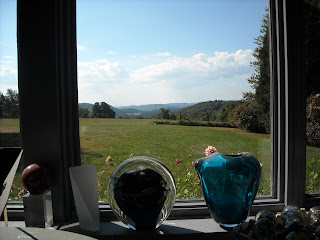

One of the first things you notice about Josh Simpson’s studio is the location. You look around and see green trees parting to show a beautiful view of the valley. It’s this view that drew Simpson to this spot. The other thing was the house also had a large barn where he could set up his studio. The first thing he points out is about a dozen roughly fifteen foot logs with sharpened ends resting on the beams above. He keeps these as a reminder that in 1971 he had to live in a canvas Tepee in an area of land he rented in Vermont. “I still think I might end up there again,” he says with a laugh.
As you keep walking he brings you to the hot shop. It lives up to its name. The first thing that hits you is the warmth. It’s not unbearable; it’s like being in a giant cozy blanket. It’s a huge room that’s lit up by the large windows that take up two walls showing off that beautiful view. Here the furnace runs 24/7 and has to be about 2100 to 2400 degrees Fahrenheit for working. As he opens the door the orange heat lets out a barely audible low hum and you feel the hot air flowing over you. You keep staring into the orange void even after he shuts the door.
In 1976 a teacher asked him to do a demonstration for a group of eighth graders. He happily agreed. Little did he know it meant for the next month every Wednesday he’d be doing a demonstration. He quickly learned the kids would get bored with vases and goblets. He found himself looking at the photo of Earth taken on the Apollo mission and decided to try making a world to show the kids how precious and fragile the earth is. He did this for six years before he started selling them.
Now they have been literally all over the globe, either in shows in New Zealand or Prague, or at the North Pole or the Great Wall of China from his Infinity Project.
But it’s here in this studio in Shelburne Massachusetts that they are born. You can see that this is almost a habit to him now as he goes through the process of making his globe. But it seems to have lost none of its magic for him. He talks enthusiastically as he shows you the stages of the process. First he puts a long metal rod into the rumbling furnace and pulls out, as if by magic, a glowing orange glob. He moves quickly to a corner in the hot shop where he coats this layer with silver. He lists the different compounds of silver as he goes and you can tell he enjoys the science of glass making almost as much as the physical work. He moves to a second furnace and puts a layer of black glass over the first layer. This will become the planet’s ocean. He moves to a table covered in small handmade pieces of glass cane that will become continents. With a fluid motion he dusts it with a pink glass dust and a fluttering piece of gold leaf. Then he scans his continents and picks a few. Once this process is finished he puts on a layer of clear glass and places his floating ship. He wouldn’t let me tell you how he does that, it’s one of his secrets.
Once he’s done, he hands it to his assistant Rick, whose regular job is as the local fire chief. Simpson jokes that if there’s ever a fire they let Rick take care of it. Rick forms the planet into its perfect spherical shape. He cups it in wooden shaping tools that are immersed in water. Simpson doesn’t hesitate to tell you it isn’t as easy as it looks.
Next they’re handed off to Simpson’s other assistant Erin who inspects the planet for imperfections. Then, with thick leather gloves and great care, she taps the globe at the base to break it free from the stick. She quickly puts it in a cooling furnace. You can tell it’s hot by her flinches.
Sorry if this post is a little long. Let me know if there's anything I can improve!
nice job, Lily, Ms C
ReplyDeletevery nice article on Josh....I've been a fan of his work for years...very special and unique pieces! I'd like to see more photo's. I like the length of your post.
ReplyDelete